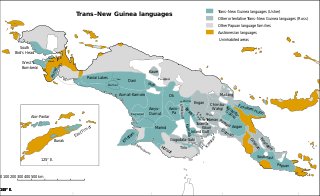
Trans–New Guinea (TNG) is an extensive family of Papuan languages spoken in New Guinea and neighboring islands, perhaps the third-largest language family in the world by number of languages. The core of the family is considered to be established, but its boundaries and overall membership are uncertain. The languages are spoken by around 3 million people. There have been three main proposals as to its internal classification.

The Papuan languages are the non-Austronesian and non-Australian languages spoken on the western Pacific island of New Guinea, and neighbouring islands, by around 4 million people. It is a strictly geographical grouping, and does not imply a genetic relationship. The concept of Papuan peoples as distinct from Austronesian-speaking Melanesians was first suggested and named by Sidney Herbert Ray in 1892.
The Sko or Skou languages are a small language family spoken by about 7000 people, mainly along the coast of Sandaun Province in Papua New Guinea, with a few being inland from this area and at least one just across the border in the Indonesian province of Papua.
Taiap is an endangered language isolate spoken by around a hundred people in Gapun village of Marienberg Rural LLG in East Sepik Province, Papua New Guinea. It is being replaced by the national language and lingua franca Tok Pisin.

The West Papuan languages are a proposed language family of about two dozen non-Austronesian languages of the Bird's Head Peninsula of far western New Guinea, the island of Halmahera and its vicinity, spoken by about 220,000 people in all. It is not established if they constitute a proper linguistic family or an areal network of genetically unrelated families.
The Tor–Kwerba–Nimboran languages are a proposed family of about two dozen Papuan languages.
The Nimboran languages are a small independent family of Papuan languages in the classification of Malcolm Ross, that had been part of Stephen Wurm's Trans–New Guinea proposal. However, when proto-Nimboran pronouns are reconstructed (*genam "I" and kom or komot "thou"), they have little resemblance to the proto-TNG pronouns *na and *ga. Usher places them in a North Papuan stock that resembles Cowan's proposal.
The Ramu–Lower Sepika.k.a.Lower Sepik–Ramu languages are a proposed family of about 35 Papuan languages spoken in the Ramu and Sepik river basins of northern Papua New Guinea. These languages tend to have simple phonologies, with few consonants or vowels and usually no tones.
The Pauwasi languages are a likely family of Papuan languages, mostly in Indonesia. The best described Pauwasi language is Karkar, across the border in Papua New Guinea. They are spoken around the headwaters of the Pauwasi River in the Indonesian-PNG border region.
The Kwalean languages are a small family of Trans–New Guinea languages spoken in the "Bird's Tail" of New Guinea. They are sometimes included in a speculative Southeast Papuan branch of Trans–New Guinea (TNG), but the Southeast Papuan families have not been shown to be any more closely related to each other than they are to other TNG families.

The West Trans–New Guinea languages are a suggested linguistic linkage of Papuan languages, not well established as a group, proposed by Malcolm Ross in his 2005 classification of the Trans–New Guinea languages. Ross suspects they are an old dialect continuum, because they share numerous features that have not been traced to a single ancestor using comparative historical linguistics. The internal divisions of the languages are also unclear. William A. Foley considers the TNG identity of the Irian Highlands languages at least to be established.
The Sentani languages form a language family of coastal Indonesian Papua near the Papua New Guinea border. Sentani had been a branch of Stephen Wurm's proposal for Trans–New Guinea. The languages have lexical similarities with the Asmat–Kamoro languages, but Ross (2005) does not believe these demonstrate a genealogical relationship, and proposes instead that they are related to the East Bird's Head languages.

The Yam languages, also known as the Morehead and Upper Maro River languages, are a family of Papuan languages. They include many of the languages south and west of the Fly River in Papua New Guinea and Indonesian West Papua.
Kaki Ae, or Tate, is a language with about 500 speakers, half the ethnic population, near Kerema, in Papua New Guinea.
The Orya–Tor languages are a family of just over a dozen Papuan languages spoken in Indonesia.
Molof is a poorly documented Papuan language spoken by about 200 people in Molof village, Senggi District, Keerom Regency.
Dibiyasoa.k.a.Bainapi is a Papuan language of Western Province, Papua New Guinea. It is sometimes classified with the Bosavi languages. Søren Wichmann (2013) tentatively considers it to be a separate, independent group. Pawley and Hammarström (2018) note that similarities between Bosavi and Dibiyaso are likely due to loanwords, therefore leaving Dibiyaso as unclassified.
The Kwerbic, or Greater Kwerba, languages are a family of just under a dozen Papuan languages spoken in Indonesia.
The Lepki–Murkim languages are a pair of apparently related but otherwise isolated languages of New Guinea, Lepki and Murkim.
The Tor–Kwerba languages are a family of Papuan languages. All the languages had been part of Stephen Wurm's 1975 Trans–New Guinea proposal, but he did not recognize them as a unit, retaining Kwerba within Capell's 1962 Dani–Kwerba proposal.




